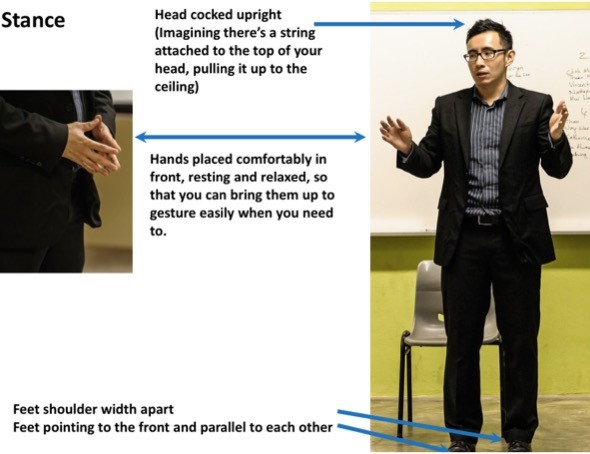You may be an expert in your work, and very competent at it. You may be at home speaking in technical terms about the project you are working on. However, when you’re speaking to your senior management team, or with your clients, speaking in such a way not only confuses people, it can amount to career suicide!
What you want is to be able to present not only confidently, but also in a interesting, memorable and compelling way. If you do, then read on to be inspired by these TED speakers:
- Body Language: Your body language shapes who you are -Amy Cuddy
http://www.ted.com/talks/amy_cuddy_your_body_language_shapes_who_you_are?language=en#t-65657
Main takeaways from this speech: Your body language dictates your mind. When you assume high-power poses (See below) you feel better and more confident. Assume high power poses for 2min before your Presentation starts. Do this in the washroom before entering the assessment room.
During the presentation, avoid low power poses. Do not fold your arms or hold your hands together in front of you in a V-shape. Gesture naturally and keep your arms “open” as much as possible. Note how the speaker does this. If you do not know what to do with your arms, simply let them hang by your side.

The secret structure of great talks -Nancy Duarte
https://www.ted.com/talks/nancy_duarte_the_secret_structure_of_great_talks
Nancy Duarte introduces a structure that we can all adopt to organise our ideas in our presentations.
“So at the beginning of the presentation, you need to establish what it is. You know, here’s the status quo, here’s what going on” –Nancy Duarte, 6:45
When you begin your presentation, tell your audience what the situation is CURRENTLY like, and then tell them what the FUTURE could look like. Show the contrast between the present and the ideal.
“The middle goes back and forth. It tranverses between what is and what could be, what is and what could be.” –Nancy Duarte, 7:30
When you constantly go back between what is and what could be, you are actually going to sway your audience towards your perspectives faster than if you don’t. You are consistently CONTRASTING the current situation with the future, ideal state. You are getting them excited about the transformation that is about to occur.
While you are explaining the “shortfalls in current measures” in your presentation, remember to juxtapose that with what you are about to achieve.

“The last turning point is the call to action which every presentation should have. But at the very end, you need to describe the world as a new bliss. This is utopia with my idea adopted. Use that as an ending, in a very poetic and dramatic way.” -Nancy Duarte, 8:25
In other words, end with a bang! Rehash your desired outcome (with an image or otherwise), and empower your audience by telling them that “you can make the difference”.
Notice how Nancy delivers her speech. She pauses at appropriate times; she varies her intonation and speech and uses metaphors (sailing boat) to put her message across. Note also how she tries to create intimacy with the audience by sharing her family background. Many of us aren’t going to have a compelling personal story, but through our personal observation, we can tell anecdotes of others. (E.g. a homeless elderly) People like to hear stories.
How great leaders inspire action -Simon Sinek
https://www.ted.com/talks/simon_sinek_how_great_leaders_inspire_action
Simon Sinek tells you why you should start by asking WHY, HOW then WHAT. Here’s an example of how Apple markets its iPhone:
WHY “Everything we do, we believe in challenging the status quo. We believe in thinking differently.”
HOW “The way we challenge the status quo is by making our products beautifully designed, simple to use and user friendly.”
WHAT “We just happen to make great computers. Want to buy one?”
In your opening speech, tell your audience what are your group’s values, beliefs, and guiding philosophy. Carry this line of thinking throughout your whole presentation and you are bound to awe everyone with your presentation.
Remember, People don’t buy what you do; they buy why you do it.
Using visuals: Are athletes really getting faster better stronger -David Epstein
http://www.ted.com/talks/david_epstein_are_athletes_really_getting_faster_better_stronger#t-16233
Your powerpoint slides should mostly be composed of pictures, not words. As much as you can, you should try to avoid bulletpoints. Look at how David Epstein manages to do this with just pictures and graphs, no words.
(Refer to 1:38) Your powerpoint slide can serve as a picture aid to help your audience imagine a scene. For example, you may use this at the ending, where you impel your audience to imagine a utopia made possible by your group’s proposal and end on a high note.
Think about your slides last. Presenters tend to make the mistake of making their powerpoint slides first and then craft their speech accordingly. Instead, think of powerpoint slides as an accessory that complement your main presentation. Now reverse the order: Do your speech, then insert the slides.
A final word on the use of props: props are not absolutely necessary, but if you have a product to show, or if you intend to use a recurring motif throughout your presentation, props add a fine touch.
You may want to look at http://www.ted.com/talks/andy_puddicombe_all_it_takes_is_10_mindful_minutes
To have a sense of how good presenters incorporate props seamlessly into their speech. Used inappropriately, props can become a distraction.




